How to Install Zippers
You find a knitting pattern that’s perfect – the right yarn, the best fit, some incredible details—but you put it aside because you don’t want to deal with the dreaded zipper. Zippers aren’t difficult to install, but they do require attention to detail and careful measurement. Here is a step-by-step tutorial, along with a few tricks to ensure proper placement and avoid common zipper pitfalls.
Selecting Your Zipper

There are a number of different kinds of zippers available, and the one you select will depend on the needs of your project. If your project opens up like a jacket or cardigan, use a separating zipper. Skirts and necklines use non-separating zippers.
The material of the zipper makes a difference, too. For lighter-weight knits, use a nylon or plastic zipper. For bulkier projects, use a metal zipper that can stand up to heavy use.
You also have to decide how you would like to place your zipper within your garment. Do you want the zipper to run up all the way to the top and bottom edges of the opening, or do you want to have the zipper run short and allow the exposed edge of the knit to show?
To calculate the length of your zipper, first measure the length of the opening in your garment. Zippers come in standard lengths (9″, 12″, 18″, 24″, etc.) and if the length you need is between standard sizes, it is better to buy a zipper that is too long for your garment and shorten it.
Installing Your Zipper
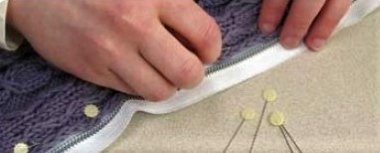
Step One
Open the zipper and decide which side of the garment opening you will do first.
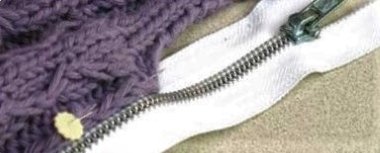
Step Two
Place the edge of the knit fabric as close to the zipper teeth as you can, but not so close that the zipper head catches the fabric when you slide it.


Step Three
If it makes you more comfortable, baste the zipper in place using thread in a contrasting color. Use a long running stitch so that you can easily remove it when you’re done. Make sure that you’re going through both the zipper and the knitted fabric—you don’t want the zipper to slip around.
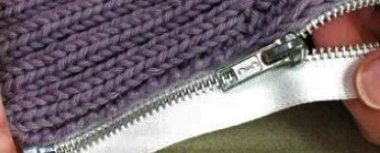
Step Four
Using hand sewing thread to match your knit fabric, back stitch the zipper by hand from the right side (we used red thread for demonstration purposes only). You’ll want to nestle your stitches along the selvedge edge of the knit fabric so they are invisible. Again, make sure to double-check that the zipper head can move freely and the zipper opens without problems.


Step Five
Repeat with the other side of the zipper.
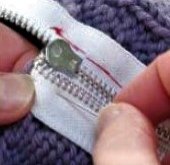
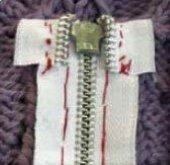
Step Six
Turn under the end of the zipper tape and stitch into place. Cut off any excess zipper length.
Note: Do not cut the extra length of zipper until the zipper is completely installed and the top ends are tacked down securely.
Tricks for Complicated Zippers
- Fuzzy yarns can be problematic with zippers – make sure that your zipper teeth don’t catch on stray fibers of flyaway threads of your yarn.
- Never machine sew a zipper into a hand knit garment. The difference in tension caused by the bulk of the knit fabric will make the zipper ripple. If the knit fabric gets stretched out during zipper installation, your zipper with look like a rollercoaster down the front and bulge out in strange places.
- Sew the zipper in carefully so that your stitching doesn’t distort your knitted fabric.
- Consider using grosgrain ribbon to cover the edges of the zipper. It will keep your edges looking clean, prevent wear on the stitches holding the zipper in place, and can be a nice accent to your garment.
How to Shorten Your Zipper
- Shorten both separating and non-separating zippers at the top.
- It is best to fold back the excess zipper fabric at a slight angle and tack down by hand stitching it into place.
- If you shorten the zipper by cutting away the extra zipper fabric, you must stitch across the zipper teeth so that the zipper head cannot be accidentally pulled off.







